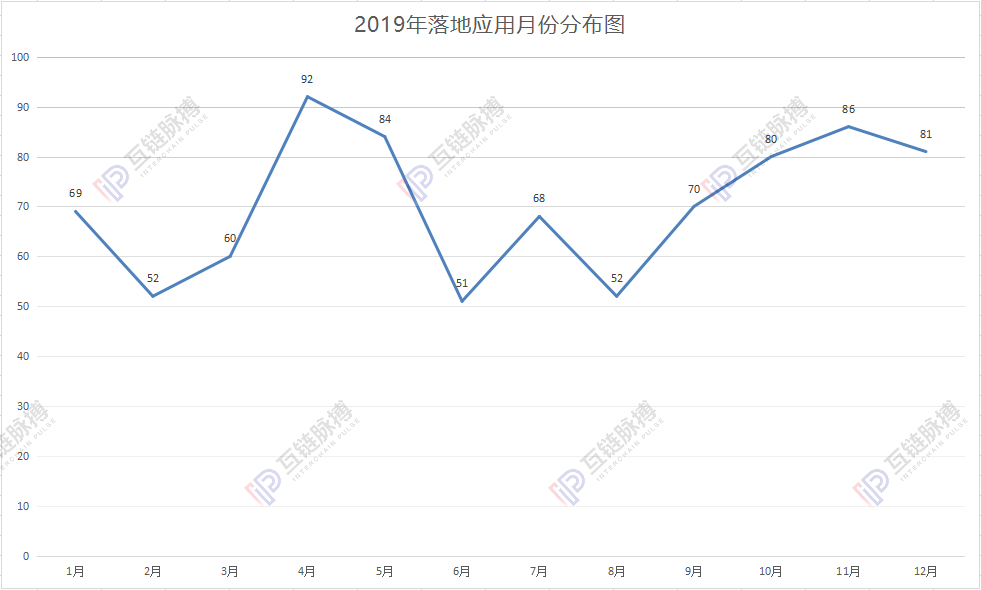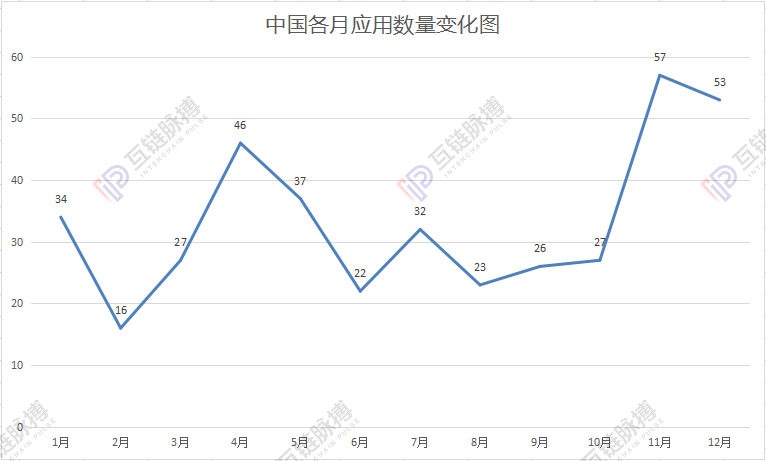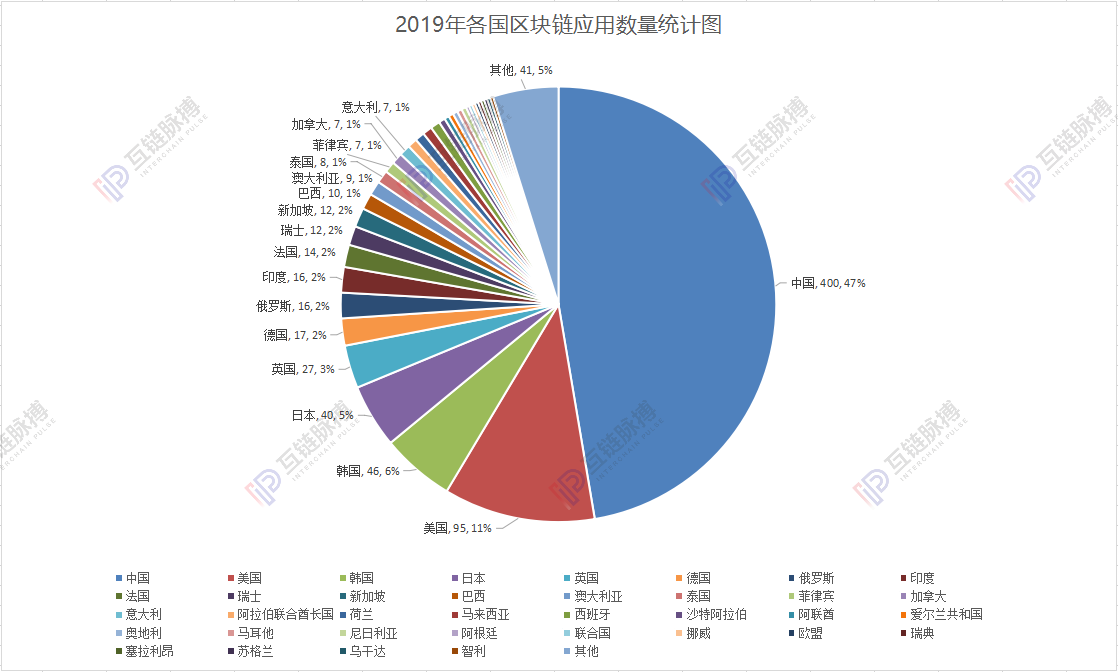Blockchain landing application 2019 statistics: government affairs and finance occupy half of the country, and China's blockchain landing volume has reached the world
Text | Interchain Pulse · Black Pearl
Learn from the past and know the future. In the just past 2019, the use of blockchain in the field of crypto assets has attracted the attention of countries around the world. Behind the hot spots, the application of blockchain in the existing economic system is steadily advancing and gradually penetrates into the people of all countries Every aspect of life.
According to the statistics of the Interlink Pulse Institute, in the first half of the year, a total of 408 landing projects were disclosed worldwide, in the second half of the year, 437 items were disclosed, and about 70 items were disclosed on average every month.
On the one hand, the number of landings indicates that the application of blockchain technology is steadily advancing, and the value of blockchain to various industries is being proven. On the other hand, the mutual chain pulse has found through the content of each landing project that the application of blockchain in various industries such as finance, government affairs, and trade has been deepened, and it has spawned some native new products. At the same time, based on these applications, theories about blockchain application scenarios are also being constructed.
- Can Andrew Yang's White House Crypto Party be held successfully in 2020?
- Comment: Regulatory sandbox and blockchain coexist and help innovation
- Supervision stick, giant "encirclement and suppression", how does the crypto industry redeem itself?
Landed applications develop steadily, and financial and government projects remain flat
According to public information, this year, a total of 845 projects have been implemented in various countries around the world, of which the largest number of projects was April, a total of 92, and the lowest number of projects was June, a total of 51 projects were disclosed. Judging from the quantity alone, 408 cases in the first half and 437 cases in the second half belong to the same level.

(Mapping: Interlink Pulse Academy Data source: public information)
The number of blockchain landings in 2019 has been remarkable, and the role of blockchain in solving real industry pain points has become increasingly significant. In December, several parks of the State Grid Shandong Electric Power Company reduced the design capacity of charging piles by 57%, reduced the overall electricity cost by 7%, and increased photovoltaic revenue by 12% by constructing a blockchain distributed energy trading platform. The State Administration of Foreign Exchange, in conjunction with the "Cross-Border Financial Blockchain Service Platform" declared by China Banknote, reduced the verification time from 1 day to 20 minutes. By the end of the year, the number of Shenzhen block chain electronic invoices had exceeded 14 million …
Looking at the application in 2019, of the 846 projects, they cover 12 application areas with a total of 100+ application scenarios. In terms of application areas, finance and government affairs led the way, and the number of landings in both areas remained the same throughout the year, both of which were 214, accounting for 50% of the total.
In addition, there were 153 landing projects in the field of trade and logistics, accounting for 18%, which was the third largest landing area. Social services, public utilities and the energy sector were also the focus of landing in the second half of the year. Among them, 32 projects were completed in the energy department in half a year. The 16 projects in the first half of the year increased by 200% from the previous month.

(Mapping: Interlink Pulse Academy Data source: public information)
The financial field has always been regarded as the best application scenario of blockchain technology. Since 2019, in the application of blockchain in the financial field, cross-border services based on cross-border payments, and inclusive financial products such as supply chain finance for small, medium and micro enterprises have been the focus of implementation.
It is worth mentioning that the use cases of blockchain in cross-border finance are more prominent, with a total of 38 cases recorded. Among them, China has the largest number of cross-border service applications, with 18 cases. From a global perspective, Southeast Asian countries are more keen on cross-border applications than European and American countries. For example, Thai Commercial Bank Ayutthaya Bank launched a blockchain solution in November that can be used for cross-border payments and trade between Thailand and Laos; the Central Bank of Cambodia tested digital wallet (Bakong) in October to simplify cross-border payments …

(Mapping: Interlink Pulse Academy Data source: public information)
In terms of inclusive financial products, China's four major banks, industries, banks, core companies, and technology companies have entered the bureau, and they are also used internationally. In November, the Bank of China Zhejiang Branch launched the "Tmall Dealer Supply Chain Financing Product"; in October, the "China-Europe e-Single Link" developed by the head office of the Industrial and Commercial Bank of China was officially opened in the Qingbaijiang Railway Port Area of the Sichuan Pilot Free Trade Zone. Provide trade logistics information support for SME financing; Singapore's largest commercial bank DBS Bank launched a multi-layer financing tool on the logistics blockchain platform in September to help Chinese SMEs obtain trade financing faster.
In addition to finance, government affairs have also been the focus of implementation. Some people think that government affairs may be more suitable for blockchain applications. Wang Jing, a partner and head of the blockchain business at Ernst & Young, said at the "IN-CHAIN Global Blockchain Summit" in December that blockchain has not yet become the mainstream technology in the financial industry, but in many countries, blockchain Has become the mainstream technology in the field of smart government affairs.
The government's acceptance of blockchain is increasing. In July 2019, the data directories of all government departments in Beijing were locked and shared in the form of a blockchain, forming a "directory chain". On this basis, the data can be used to finance private small and micro enterprises. In addition, domestic cities such as Jinan, Loudi, and Qingdao have successively carried out the construction of digital governments. Foreign countries such as Bermuda, Japan have developed a blockchain-based national identity card system; Malta's national commercial registry has introduced blockchain technology; the Brazilian government of Sao Paulo will register public works projects through the blockchain.
Blockchain applications are also widely used in entertainment, social and content, industrial, and daily consumption. At the same time, some native applications of blockchain have emerged in 2019, such as in the public welfare, giving participants behavioral value, and the value can be converted.
Starting in November 2019, the Taoyuanju Community in Jian'ou District, Nanjing has piloted the storage of public welfare time in Alipay, redeemed pension services, and recorded the entire process on the blockchain. In December, Alibaba's 3-hour charity platform announced that it will use blockchain technology to make it recordable, shareable, and incentivizable during charity. Putuo District of Shanghai in March used "blockchain technology" to combine community home care and neighborhood mutual assistance to launch a "time bank" pilot for old-age care services.
In combination with previous application cases, the question "Blockchain can be used, but where should it be used?" Has basically been answered in 2019: in scenarios that require multi-party collaboration, need to process a large amount of data, and require trust transfer.
China leads the way, national pattern of top ten blockchain applications
Regarding the country as the boundary, among the countries in the world, China has the largest number of blockchain applications, with a total of 400, accounting for 47% of the total.
Affected by the favorable policies in China at the end of October, the number of disclosures at the end of the year had a large increase. 57 items were disclosed in November, an increase of 111% from the previous month. It also remained at a high level in December, disclosing 53 applications.

(Mapping: Interlink Pulse Academy Data source: public information)
In terms of application areas, China and the world's applications cover government affairs, finance, trade logistics, social services and public utilities, social and content, entertainment, information technology services, energy, daily consumption, industry, agriculture, and other total 13 areas.
China's landing applications are mainly government affairs, with a total of 142 items, accounting for 36%; secondly, there are 94 projects in the financial field, accounting for 24%; in addition, trade logistics, social services and public utilities, social and content, entertainment, information The fields of technical services, energy, daily consumption, agriculture, other, and industry have landed 64, 44, 14, 10, 10, 8, 5, 4, 4, and 1 applications respectively.

(Drawing: Mutual Chain Pulse Editorial Department Data Source: Public Information)
Outside of China, the top ten blockchain application countries in 2019 are the United States, South Korea, Japan, the United Kingdom, Germany, Russia, India, France, and Switzerland. The number of applications that have landed respectively: 95, 46, 40, 27, 17, 16, 16, 14, 12 items. According to the Interim Pulse Research Institute's semi-annual report released in July 2019, the top ten application countries in the first half of 2019 are also these countries. However, in the second half of the year, the number of British and German applications was 18 and 10 respectively, which was 200% and 142% higher than the 9 and 7 items in the first half of the two countries respectively, ranking and migrating, ranking fifth and sixth.

(Mapping: Interlink Pulse Academy Data source: public information)
At the same time, the landing options of the top ten application countries in the second half of 2019 were slightly adjusted from the first half. In the first half of the year, China, Russia, and South Korea gave priority to the development of government affairs. The United Kingdom, India, and India paid the most attention to finance. The United States, France, and Switzerland were more inclined to use blockchain technology to trace the source.
In the second half of the year, the United States developed a number of financial and energy businesses, such as the oil giant OOC Oil and Gas Blockchain Alliance, and international commodity transportation and freight forwarder Murphy Global Logistics only adopted the blockchain platform to simplify smart contracts in the oil and gas industry . American insurance brokerage company Marsh, Mastercard, and reinsurance group subsidiary RGAX have launched blockchain applications in succession. South Korea ’s financial applications are also increasing in the second half of the year, such as launching real estate digital securities and supply chain financial products. In Japan, the exchange of power based on blockchain technology is still the focus of landing, and it combines blockchain technology with renewable new energy applications. In October, TBS Holdings used blockchain technology to switch electricity from the company's theaters and homes to renewable energy. In August, the Japanese electric power company Minden supplied renewable energy power to Chiba University of Commerce in Japan. The company determined the power generation through blockchain technology and could reliably supply solar power to schools.
In 2019, the blockchain application race in various countries in the world has begun to see high and low levels, and the applications in the financial and government fields are on a par with each other. The development of blockchain technology and the needs of existing industries continue to promote the application. In 2020, whether the blockchain application will continue the record of 2019 or go out of a new mode, let us wait and see!
This article is the original [Interlink Pulse], the original link: https://www.blockob.com/posts/info/31978 , please indicate the source when reproduced!
We will continue to update Blocking; if you have any questions or suggestions, please contact us!
Was this article helpful?
93 out of 132 found this helpful
Related articles
- Interviewed 800 crypto traders in 75 countries around the world. What did they find?
- Ethereum implements Muir Glacier upgrade, V god praises Sparkpool mining pool
- A New Decade of Digital Currency Trading: Looking at the Past to See the Future
- Dry goods | Can quantum computers really destroy blockchain networks?
- The digital currency pilot is expected to land in Shenzhen, and will enter transportation, education, medical and other service scenarios
- China's First Unsecured Blockchain Loan Issuance, Guangdong Launches SME Financing Platform
- Research | Domestic encryption algorithm combat government affairs alliance chain Can they replace mainstream public chain algorithms?






